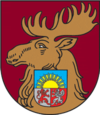Mitau
| Jelgava | |||
|---|---|---|---|
| City | |||

Aerial view of Jelgava
|
|||
|
|||
| Location in Latvia | |||
| Coordinates: 56°38′54″N 23°42′50″E / 56.64833°N 23.71389°ECoordinates: 56°38′54″N 23°42′50″E / 56.64833°N 23.71389°E | |||
| Country | |||
| Town rights | 1573 | ||
| Government | |||
| • Mayor | Andris Rāviņš | ||
| • Number of city council members | 15 | ||
| Area | |||
| • Total | 60 km2 (20 sq mi) | ||
| • Water | 2.34 km2 (0.90 sq mi) | ||
| Population (1 July 2013) | |||
| • Total | 62,800 | ||
| • Density | 1,000/km2 (2,700/sq mi) | ||
| Time zone | EET (UTC+2) | ||
| • Summer (DST) | EEST (UTC+3) | ||
| Postal code | LV-300(1–9); LV-3024; LV-3035 | ||
| Calling code | (+371) 630 | ||
| Website | www |
||
Jelgava (pronounced [jælɡava]; also known as Mitau or Juulgava, see also other names) is a city in central Latvia about 41 kilometres (25 miles) southwest of Riga with about 63,000 inhabitants. It is the largest town in the region of Zemgale (Semigalia). Jelgava was the capital of the united Duchy of Courland and Semigallia (1578-1795) and the administrative center of the Courland Governorate (1795-1918).
Jelgava is situated on a fertile plain rising only 3.5 metres (11.5 feet) above mean sea level on the right bank of the river Lielupe. At high water the plain and sometimes the town as well can be flooded. It is a railway center and is also host to Jelgava Air Base. Its importance as a railway centre can be seen by the fact that it lies at the junction of over 6 railway lines connecting Riga to Lithuania, eastern and western Latvia, and Lithuania to the Baltic sea.
Until 1917, the city was officially referred to as Mitau. The name Jelgava is believed to be derived from the Livonian word jālgab, meaning "town on the river." The origin of the German name Mitau is unclear, although it is suggested that it came from the Latvian words mīt or mainīt, meaning "to exchange" or "to trade," thus making it "the place where trading takes place." An alternate explanation is that Mitau came from Mitte in der Aue, German for "the middle of the Aa", referring to the Lielupe River, formerly known as the Courland Aa (Kurländische Aa in German).
Jelgava before the Second World War had regular, broad streets lined with the mansions of the Baltic German nobility who resided at the former capital of Courland. The old castle (1266) of the dukes of Courland, situated on an island in the river, was destroyed by Duke Biren, who had a spacious palace erected (1738–1772) by Bartolomeo Rastrelli at the bridge across the Lielupe. The palace contains the sarcophagi of almost all of the Curonian dukes, except the last one. The future Louis XVIII sojourned in the palace between 1798 and 1800. It now functions as the LLU, Latvijas Lauksaimniecības Universitāte, or Latvian University of Agriculture. Other landmarks include the Baroque church of St. Anne, the tower of the destroyed Trinity church, and two handsome structures: the Villa Medem and the Academia Petrina.
...
Wikipedia



